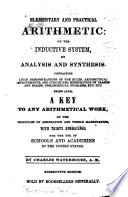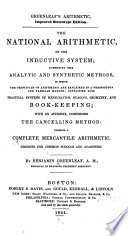 | Charles Waterhouse - Arithmetic - 1842 - 180 pages
...term, last term, and number of terms given, to find the common difference; or, sum of all the terms. RULE. — Divide the difference of the extremes by the number of terms less 1, the quotient will be the. difference. Multiply the sum of the extremes by the number of terms, half... | |
 | Roswell Chamberlain Smith - Arithmetic - 1842 - 320 pages
...•*- 5= 5 years, the common difference. A. 5 years. 11. Hence, to find the common difference, — Divide the difference of the extremes by the number of terms, less 1, and the quotient will be the common difference. 12. If the extremes be 3 and 23, and the number... | |
 | Nathan Daboll - Arithmetic - 1843 - 254 pages
...Ans. 33 miles. The first term, last term, and number o/" terms given, to find the common difference. RULE. Divide the difference of the extremes by the number of terms less 1, and the quotient will be the common difference. EXAMPLES. 1. A man bought 17 yards of cloth in arithmetical... | |
 | Roswell Chamberlain Smith - Arithmetic - 1843 - 320 pages
...then, 25-^5= 5 years, the common difference. A. 5 years. 11. Hence, to find the common difference, —Divide the difference of the extremes by the number of terms, less 1, and the quotient will 1>e the common difference. 12. If the extremes be 3 and 23, and the number... | |
 | Benjamin Greenleaf - Arithmetic - 1843 - 340 pages
...PROBLEM I. The first term, last term, and the number of terms being given, to find the common difference. RULE. Divide the difference of the extremes by the number of terms yt diffe less one, and the quotient is the common difference. 1. The extremes are 3 and 45, and the... | |
 | Pliny Earle Chase - Arithmetic - 1844 - 246 pages
...Then the difference of the extremes 24, must be 8 times the common difference, which is therefore 3. RULE. Divide the difference of the extremes by the number of terms less one, and the quotient will be the common difference. This difference repeatedly added to the less, or subtracted... | |
 | Pliny Earle Chase - 1844 - 258 pages
...Then the difference of the extremes 24, must be 8 times the common difference, which is therefore 3. RULE. Divide the difference of the extremes by the number of terms less one, and the quotient will be the common difference. This difference repeatedly added to the less, or subtracted... | |
 | George Hutton (arithmetic master, King's coll. sch.) - 1844 - 276 pages
...-:- 7 = 3, the common difference; and the whole series 3 : 6 : 9 : 12 : 15: 18 : 21: 24. Hence the RULE. Divide the difference of the extremes by the number of terms less 1, and the quotient will be the " common difference, or ratio of the progression. EXAMPLES FOR PRACTICE.... | |
 | Charles WATERHOUSE - Arithmetic - 1844 - 228 pages
...first term, last term, and number of terms, to find tiie common difference ; or sum of all the terms. RULE. — Divide the difference of the extremes by the number of terms less 1, the quotient will be the difference. Multiply the sum of the extremes by the number of terms, and... | |
 | Benjamin Greenleaf - Arithmetic - 1844 - 352 pages
...term, last term, and the number of terms being given, to find the common difference. RULE. JDivide the difference of the extremes by the number of terms less one, and the quotient is the common difference. 1. The extremes are 3 and 45, and the number of terms is... | |
| |